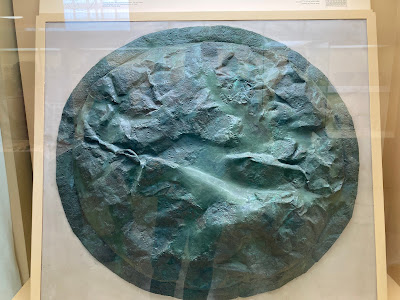The Stoa of Attalos was built at the Athenian Agora by Attalos II (ruled 159 B.C. to 138 B.C.) of Pergamum. The stoa was intended as a gift by Attalos for the education that he had received there in his youth.
As Classical Athens was subsumed into larger and larger political units - Alexander the Great's empire, the successor state of the Kingdom of Macedonia, The Achaean League, and the Roman Empire - it continued to enjoy favor based on its reputation for philosophy and culture. A number of monuments and memorials were gifted over the years (The Odeon, the great amphitheater of the Parthenon, was one; we will see more done by Romans soon). The givers sought both to bring honor to Athens as well as themselves by their gifts.
The Stoa measures 377 ft x 66 ft/115 m by 20 m and is unusual in that it has two levels, not one. The original was largely destroyed in 267 A.D. by the invading Heruli and was excavated in 1931. The Stoa was rebuilt, using original materials where possible and marble from Mt. Pentelicus used to fill in the gaps (as was true of the Parthenon as well).
A view of the reconstructed Stoa from the Temple of Hephaestus:
Looking along the side:










So fascinating to think that a cracked pot that might have once been discarded is now a priceless artifact. Looks like an amazing museum. I was thinking too, about rebuilding the Stoa. Seeing it rebuilt must inspire a different sort of awe compared to all the ruins. Maybe makes the magnitude of the ancient Greek's architectural accomplishments more impressive.
ReplyDeleteLeigh, it was a very good museum - although from our travels, Greece has many. The Acropolis Museum and the National Archaeological Museum of Greece are rated super highly (we made it to the Acropolis Museum, which was fantastic; the National Archaeological Museum will have to wait for another trip).
DeleteThe reconstruction gives a representation of what such things might have looked like in a way that artists' reconstructions and 3-D computer models cannot. In the back of my head, it does make me wish it was possible to do more of them - because as you say, it really moves them from the "primitive savages" picture to the accomplished builders and thinkers they were.
I'm not sure I would have wanted to see someone with that shield coming at me in mortal combat. I would assume they were very battle hardened and my seconds on earth were very limited at that point.
ReplyDeleteEd, they were typically 30-36" in diameter, and included a spear backing them up. The descriptions we have of the battles make them very terrifying indeed.
Delete